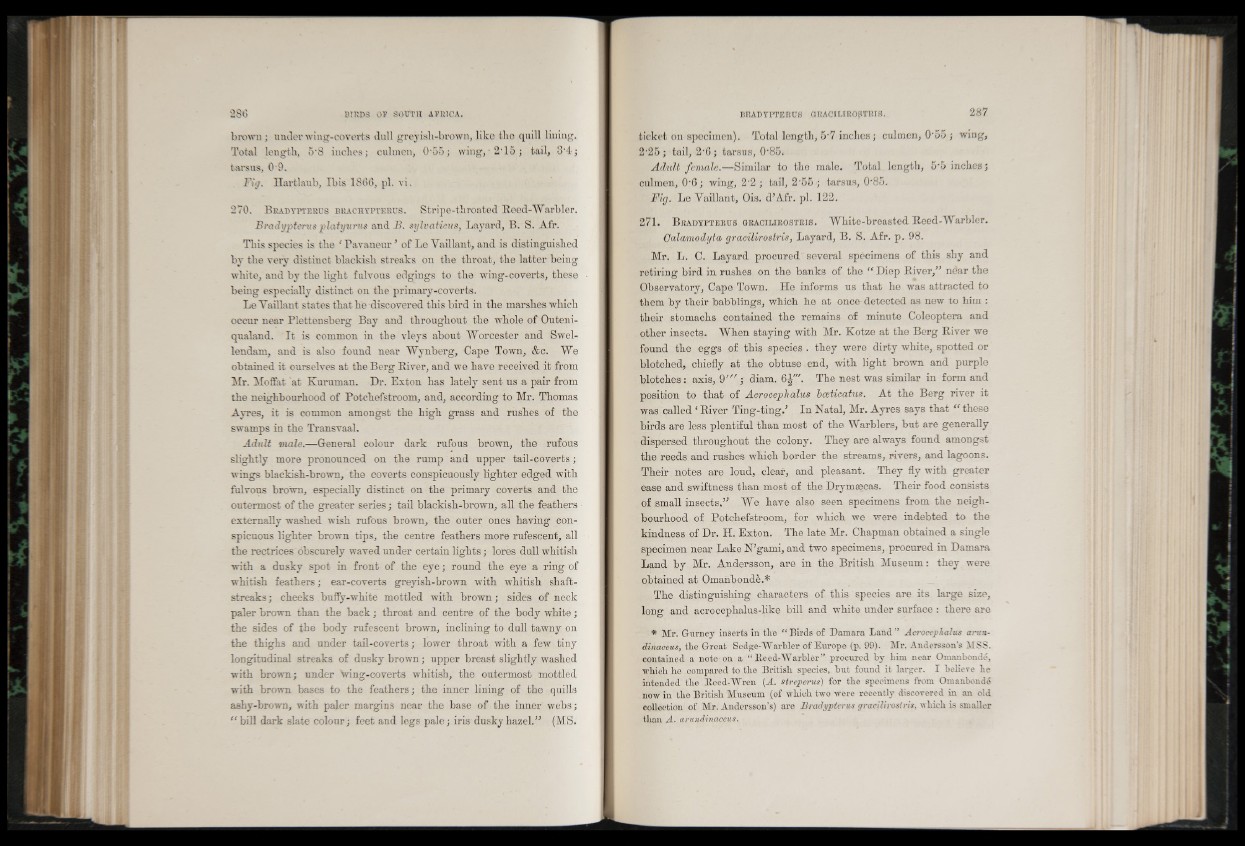
brown; under wing-coverts dull greyish-brown, liko fclio quill lining.
Total length, 5*8 inches j culmen, 0'55; wing, • 2*15 j tail, 8*4;
tarsus, 0*9.
Fig. Hartlaub, Ibis 1866, pi. vi.
270. Beadypteecs bkachypterus. Stripe-throated Reed-Warbler.
Bradypterus platyurm and B. sylvaticns, Bayard, B. S. Afr.
This species is the ‘ Pavaneur ’ of Le Vaillant, and is distinguished
by the very distinct blackish streaks on the throat, the latter being
white, and by the light fulvous edgings to the wing-coverts, these
being especially distinct on the primary-coverts.
Le Vaillant states that he discovered this bird in the marshes which
occur near Plettensberg Bay and throughout the whole of Outeni-
qualand. It is common in the vleys about Worcester and Swel-
lendam, and is also found near Wynberg, Cape Town, &c. We
obtained it ourselves at the Berg River, and we have received it from
Mr. Moffat at Kuruman. Dr. Exton has lately sent us a pair from
the neighbourhood of Potchefstroom, and, according to Mr. Thomas
Ayres, it is common amongst the high grass and rushes of the
swamps in the Transvaal.
Adult male.—General colour dark rufous brown, the rufous
slightly more pronounced on the rump and upper tail-coverts;
wings blacidsh-brown, the coverts conspicuously lighter edged with
fulvous brown, especially distinct on the primary coverts and the
outermost of the greater series; tail blackish-brown, all the feathers
externally washed wish rufous brown, the outer ones having conspicuous
lighter brown tips, the centre feathers more rufescent, all
the rectrices obscurely waved under certain lights; lores dull whitish
with a dusky spot in front of the eye; round the eye a ring of
whitish feathers; ear-coverts greyish-brown with whitish shaft-
streaks; cheeks bufly-white mottled with brown; sides of neck
paler brown than the back; throat and centre of the body white;
the sides of the body rufescent brown, inclining to dull tawny on
the thighs and under tail-coverts; lower throat with a few tiny
longitudinal streaks of dusky brown; upper breast slightly washed
with brown; under wing-coverts whitish, the outermost mottled
with brown bases to the feathers; the inner lining of the quills
ashy-brown, with paler margins near the base of the inner webs;
“ bill dark slate colour; feet and legs pale; iris dusky hazel.” (MS.
ticket on specimen). Total length, 5*7 inches; culmen, 0*55 ; wing,
2 * 2 5 ; tail, 2 * 6 ; tarsus, 0*85.
Adult female.—Similar to the male. Total length, 5*5 inches;
culmen, 0 * 6 ; wing, 2*2 ; tail, 2*55 ; tarsus, 0*85.
Fig. Le Vaillant, Ois. d’Afr. pi. 122.
271. B radypterus g r a c il ir o s tr is . White-breasted Reed-Warbler.
Galamodyta gracilirostris, Layard, B. S. Afr. p. 9 8 .
Mr. L. C. Layard procured several specimens of this shy and
retiring bird in rushes on the banks of the “ Diep River,” near the
Observatory, Cape Town. He informs us that he was attracted to
them by their babblings, which he at once detected as new to him :
their stomachs contained the remains of minute Coleoptera and
other insects. When staying with Mr. Kotze at the Berg River we
found the eggs of this species. they were dirty white, spotted or
blotched, chiefly at the obtuse end, with light brown and purple
blotches : axis, 9 7 / / ; diam. 6 | " ' . The nest was similar in form and
position to that of Acroceph alus bceticatus. At the Berg river it
was called ‘River Ting-ting.’’ In Natal, Mr. Ayres says that “ these
birds are less plentiful than most of the Warblers, but are generally
dispersed throughout the colony. They are always found amongst
the reeds and rushes which border the streams, rivers, and lagoons.
Their notes are loud, clear, and pleasant. They fly with greater
ease and swiftness than most of the Drymaecas. Their food consists
of small insects.” We have also seen specimens from the neighbourhood
of Potchefstroom, for which we were indebted to the
kindness of Dr. H. Exton. The late Mr. Chapman obtained a single
specimen near Lake N’gami, and two specimens, procured in Damara
Land by Mr. Andersson, are in the British Museum: they were
obtained at Omanbonde.*
The distinguishing characters of this species are its large size,
long and acrocephalus-like bill and white under surface : there are
* Mr. Gurney inserts in the "Birds of Damara L and” Acroeephalus arun-
dinaceus, the Great Sedge-Warbler of Europe (p. 99). Mr. Andersson’s MSS.
contained a note on a “ Heed-Warbler” procured by him near Omanbonde,
which he compared to the British species, but found it larger. I believe he
intended the Eeed-Wren (A. streperus) for the specimens from Omanbonde
now in the British Museum (of which two were recently discovered in an old
collection of Mr. Andersson’s) are Bradypterus gracilirostris, which is smaller
than A. arundinaccus.